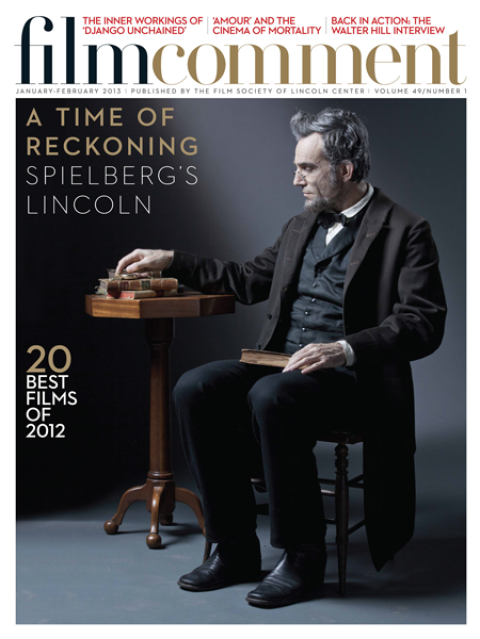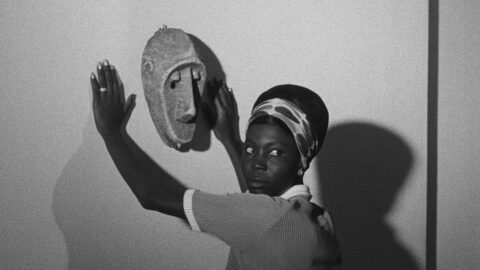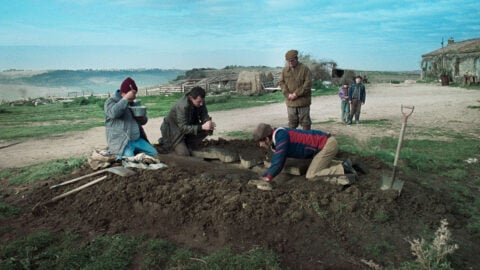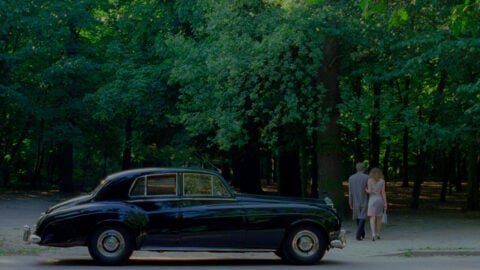
Kingdom and the Beauty

Hyenas

Distant Voices, Still Lives
“Much of what we assume about movies is off the mark. It’s time to redraw the map of movie history that we have in our heads. It’s factually inaccurate and racist by omission. The Story of Film: An Odyssey could be an exciting, unpredictable one. Fasten your seatbelts: it’s going to be a bumpy ride.”
Delivered off screen in Mark Cousins’s lilting Irish accent, this hefty promise and warning—only eight minutes into his lively, watchable, eight-part, 15-hour series—carries an undeniable thrill, even after one factors in the nod at the end to All About Eve, which suggests that some of the bumps and glitches along the way may be familiar and even predictable. I haven’t read The Story of Film: A Worldwide History, the book by Cousins that served as his starting point and has already become a collector’s item. But it’s obvious that our older maps do need to be revised geographically, culturally, and ideologically, and now that Cousins’s series has become available on DVD, one suspects that his popular and revisionist version of film history will be with us for some time, spreading its diverse illuminations and obfuscations far and wide.
“It’s time to redraw the map of movie history.” For his globe-trotting adventure, six years in the making, mixing commentary, an extensive travelogue, clips, and interviews, Cousins is certainly entitled to his subtitle, especially after one considers that he’s trying to remap certain aspects of film criticism as well. But truthfully, his innocent odyssey is, for better and for worse, closer to a theme-park ride than it is to a critical or historical essay, placing it in quite a separate universe from Jean-Luc Godard’s Histoire(s) du cinéma.
Even in the early stages of his first episode, he already displays a fair amount of boldness (and some foolhardiness) in his overall approach, exhibiting the faltering but fearless self-education of a spirited amateur. After two pairs of contrasting clips—from Saving Private Ryan and Three Colors: Blue (hyperactive and relatively uneventful, respectively, to suggest part of his overall range), then from Casablanca and Ozu’s Record of a Tenement Gentleman (to demonstrate how he wants to redefine classicism in favor of the latter over the former)—Cousins proudly and likably declares that the driving force behind movies isn’t money but ideas. And the first example of what he means by this is bold and wrongheaded in roughly equal measure.
Bold: Juxtaposing clips from Reed’s Odd Man Out, Godard’s 2 or 3 Things I Know About Her, and Scorsese’s Taxi Driver, Cousins traces a visual and thematic idea evolving from the bubbles of split beer in the first to the bubbles in a cup of coffee in the second to Alka-Seltzer dissolving in a glass of water in the third. He maintains that in all three, a character looking into the bubbles can see his own troubles “and also, somehow, the cosmos.”
 |
 |
 |
| Odd Man Out | 2 or 3 Things I Know About Her | Taxi Driver |
Wrongheaded: (1) One can easily accept this description of the first and third clips, but there’s no character at all in the second clip (which begins with a brief shot of a random café customer, as if to mislead us into thinking that he’s the scene’s designated character)—unless one postulates that it’s Godard himself, whispering his philosophical musings off screen, which Cousins doesn’t. He doesn’t even identify or translate the barely audible wisps of Godard’s commentary that leak through in the clip and provide at least half of its meaning. (2) Cousins’s claim that “this film’s director, Jean-Luc Godard, knew and admired Carol Reed’s work, so he’s probably thinking about Odd Man Out” is a preposterous stretch: in the 1,149 pages of Godard’s collected criticism in French, there’s only one passing reference to Reed, and it’s unambiguously contemptuous. And even if we can posit some vague philosophical relation between James Mason in Odd Man Out seeing figures from his past in beer bubbles and Godard reflecting on his more abstract existential dilemmas over a gigantic close-up of a cup of coffee, the odds that Godard was thinking of Odd Man Out seem pretty close to zero. (Susan Sontag’s suggestion that he may have been thinking about Francis Ponge—the brilliant prose poet who wrote exclusively about ordinary objects, such as soap—is far more plausible.)
I’ve devoted more space to Cousins’s wrong-headedness than to his boldness, but I should quickly add that his boldness and originality may in some respects be more important. The Story of Film is clearly inspired in part by the plethora of choices nowadays facing serious, non-specialist filmgoers, and sending those people off to discover the Reed and Godard films—I assume they’ve probably already seen the Scorsese—is a great idea. And Cousins’s series is full of such helpful suggestions, as well as several outlandish juxtapositions and comparisons to support many of those suggestions, which keep things fresh even when they’re contrived.

Tokyo Story

The Holy Mountain

The Emperor's Naked Army Marches On
In Part 6: “If John Ford had been into Buddhism, ballet, and zero gravity, he might have made films like King Hu.” (Yes, but maybe he wouldn’t have. And maybe if Cousins had spent more time with either director, he wouldn’t have come up with such tortured reasoning.) In Part 8, to talk about deep focus, rather than depend only on the usual Bazinian examples from early Welles and Wyler, he offers us clips from Wyler’s The Best Years of Our Lives, Haneke’s Code Unknown, and Tarr’s Sátántangó, and he also compares the way Brad Pitt is filmed in Andrew Dominik’s The Assassination of Jesse James by the Coward Robert Ford to the way Lillian Gish is filmed in Griffith’s Way Down East. No less provocatively, but more purposefully (and poetically), after a look at In the Mood for Love in Part 7, he notes: “As in the films of Rainer Werner Fassbinder and Terence Davies, hope has left the building, so rapture has migrated into the imagery and sounds.” But in the same section, Jaws is cross-referenced with Vertigo, and Cousins even buys William Friedkin’s dubious claim that he drew his methodology for The Exorcist from Howard Hawks (unless he was thinking, perhaps, of some of the flashier shock cuts in The Thing)—adding irrelevantly that Friedkin had been dating Hawks’s daughter around that time, as if that proved something.
It’s important to add that Cousins’s guiding voice on the soundtrack is anything but dogmatic. Arguably, historians and critics, particularly those who want to be lively, are entitled to be wrong at least part of the time. Consider, for instance, the early criticism of Noël Burch, littered with factual errors but often much more imaginative and fruitful than the correct but boring academic writing of others during the same period.
Here’s how Cousins described his intentions to Michael Guillén in an interview posted on Guillén’s blog The Evening Class: “The tone was crucial for me. I thought a lot about the tone. What I knew I didn’t want was a kind of TV tone, which is fast. I didn’t want the narrative voiceover to move fast. In the recording booth, I didn’t want to lecture. I wanted to create the sense that I was sitting beside you in the audience looking at the screen with you, talking in your ear. I know it’s a bit whispery and some people hate that, but—if you’re interested in the poetics of something—you almost need to get a slightly nighttime feel. Whether that works, I don’t know, but that’s clearly what I was going for.”
You might even say that Cousins wants to be our friend rather than our teacher. By the same token, he is usually content to stick with what’s already known or believed about some figures, or to revise received wisdom about them only slightly. So it shouldn’t be too surprising to hear him report that Carl Dreyer “was brought up in a strict Protestant family”—a myth that has by now been circulating for over half a century, though it’s flatly contradicted by such Dreyer biographers as Maurice Drouzy and Jean and Dale D. Drum.
More generally, when it comes to inclusions and exclusions, determining to what extent Cousins’s historical and canonical revisions represent progress as opposed to regression is no simple matter.
Richard Roud introduces his two-volume, very French-influenced Cinema: A Critical Dictionary in 1980—an indispensable compendium of Franco-Anglo-American critical thought of the Sixties and Seventies—by categorically (and, at that time, uncontroversially) declaring: “The United States, France, Germany, Italy, Sweden, Russia, and Japan: these seven countries have produced, shall we say, 95 percent of the world’s cinematic masterpieces.” Cousins’s survey, with its emphasis on Africa, China, India, Iran, and other cinematic hotbeds overlooked in other histories, decisively and usefully refutes that claim, and it’s delightful to find such figures as Youssef Chahine, Souleymane Cissé, Forough Farrokhzad, Ritwik Ghatak, Hou Hsiao-hsien, Jia Zhang-ke, Abbas Kiarostami, Mohsen and Samira Makhmalbaf, Satyajit Ray, Ousmane Sembene, and Tsai Ming-liang, among many others, brought into the picture. But this same survey, perhaps in a fit of absentmindedness, also manages to omit entirely Louis Feuillade—a supreme giant who assumed a treasured place in Roud’s pantheon after having been critically neglected everywhere for well over half a century. In short, two steps forward, one step back. In the Guillén interview, Cousins cites Sam Fuller, Eric Rohmer, Jacques Rivette, and Maya Deren as just a few regrettable omissions. (For a list of clips that do appear, go to the Wikipedia entry for The Story of Film.)
One also gets the distinct impression that the closer Cousins gets to the present, the less critically reliable and more gullible he becomes about both fashion and directorial braggadocio. Is Matthew Barney really a more significant and talented figure in the avant-garde than Michael Snow? In contrast to such an absurd notion, one might turn to this passage in J. Hoberman’s recent Film After Film: “There are more ideas in any single minute [of Corpus Callosum] than in the entirety of an overwrought 57th Street yard sale like Matthew Barney’s Cremaster.” But Cousins has a weakness for overwrought yard sales, as his unswerving devotion to Baz Luhrmann, Christopher Nolan, and Lars von Trier repeatedly demonstrates—as well as an obvious lack of ease and fluency when it comes to experimental filmmaking in general, a discomfort that someone like Barney banks on by providing a “digestible” mainstream alternative, rather as Nolan’s Memento provides an unthreatening crossword-puzzle version of the early features of Alain Resnais.
Admittedly, Cousins is far from alone in treating Dogma as a serious movement in film and film theory—as monumental, say, as Sergei Eisenstein’s ideas about montage or Cesare Zavattini’s formulations about Italian neorealism—rather than as an inspired and spectacularly successful business move that got the press at Cannes to pay more attention to Danish filmmakers. Resourceful self-packagers have nearly always found a more hospitable place in film histories than innovators without publicity smarts or big bucks at their disposal, and whenever we assert that film history needs to be revamped, we also have to remember that history is written by the victors, not the vanquished. Whether or not Cousins likes or acknowledges it, money often remains the driving force behind his version of film history, ideas (or “ideas”) included; indeed, it’s hard to imagine how it could be otherwise. To put it crudely, we all get the history we pay for.








